您好,登錄后才能下訂單哦!
您好,登錄后才能下訂單哦!
本篇內容主要講解“Linux的Platform總線結構體怎么使用”,感興趣的朋友不妨來看看。本文介紹的方法操作簡單快捷,實用性強。下面就讓小編來帶大家學習“Linux的Platform總線結構體怎么使用”吧!
一、概念
嵌入式系統中有很多的物理總線:I2c、SPI、USB、uart、PCIE、APB、AHB
linux從2.6起就加入了一套新的驅動管理和注冊的機制platform平臺總線,是一條虛擬的總線,并不是一個物理的總線。
相比 PCI、USB,它主要用于描述SOC上的片上資源。platform 所描述的資源有一個共同點:在CPU 的總線上直接取址。
平臺設備會分到一個名稱(用在驅動綁定中)以及一系列諸如地址和中斷請求號(IRQ)之類的資源。
設備用platform_device表示,驅動用platform_driver進行注冊。
與傳統的bus/device/driver機制相比,platform由內核進行統一管理,在驅動中使用資源,提高了代碼的安全性和可移植性。
二、platform
1. platform總線兩個最重要的結構體
platform維護的所有的驅動都必須要用該結構體定義:
platform_driver
struct platform_driver { int (*probe)(struct platform_device *); // int (*remove)(struct platform_device *); void (*shutdown)(struct platform_device *); int (*suspend)(struct platform_device *, pm_message_t state); int (*resume)(struct platform_device *); struct device_driver driver; const struct platform_device_id *id_table; bool prevent_deferred_probe; };該結構體,用于注冊驅動到platform總線,
| 成員 | 含義 |
|---|---|
| probe | 當驅動和硬件信息匹配成功之后,就會調用probe函數,驅動所有的資源的注冊和初始化全部放在probe函數中 |
| remove | 硬件信息被移除了,或者驅動被卸載了,全部要釋放,釋放資源的操作就放在該函數中 |
| struct device_driver driver | 內核維護的所有的驅動必須包含該成員,通常driver->name用于和設備進行匹配 |
| const struct platform_device_id *id_table | 往往一個驅動可能能同時支持多個硬件,這些硬件的名字都放在該結構體數組中 |
我們編寫驅動的時候往往需要填充以上幾個成員
platform_device
platform總線用于描述設備硬件信息的結構體,包括該硬件的所有資源(io,memory、中斷、DMA等等)。
struct platform_device { const char *name; int id; bool id_auto; struct device dev; u32 num_resources; struct resource *resource; const struct platform_device_id *id_entry; /* MFD cell pointer */ struct mfd_cell *mfd_cell; /* arch specific additions */ struct pdev_archdata archdata; };| 成員 | 含義 |
|---|---|
| const char*name | 設備的名字,用于和驅動進行匹配的 |
| struct devicedev | 內核中維護的所有的設備必須包含該成員, |
| u32num_resources | 資源個數 |
| struct resource*resource | 描述資源 |
struct devicedev->release()必須實現,
其中描述硬件信息的成員struct resource
0x139d0000
struct resource { resource_size_t start; //表示資源的起始值, resource_size_t end; //表示資源的最后一個字節的地址, 如果是中斷,end和satrt相同 const char *name; // 可不寫 unsigned long flags; //資源的類型 struct resource *parent, *sibling, *child; }; flags的類型說明 #define IORESOURCE_MEM 0x00000200 //內存 #define IORESOURCE_IRQ 0x00000400 //中斷內核管理的所有的驅動,都必須包含一個叫struct device_driver成員, //男性描述的硬件,必須包含struct device結構體成員。 //女性
struct device_driver { const char *name; struct bus_type *bus; struct module *owner; const char *mod_name; /* used for built-in modules */ bool suppress_bind_attrs; /* disables bind/unbind via sysfs */ const struct of_device_id *of_match_table; const struct acpi_device_id *acpi_match_table; int (*probe) (struct device *dev); int (*remove) (struct device *dev); void (*shutdown) (struct device *dev); int (*suspend) (struct device *dev, pm_message_t state); int (*resume) (struct device *dev); const struct attribute_group **groups; const struct dev_pm_ops *pm; struct driver_private *p; };其中:
const char *name;
用于和硬件進行匹配。
內核描述硬件,必須包含struct device結構體成員:
struct device { struct device *parent; struct device_private *p; struct kobject kobj; const char *init_name; /* initial name of the device */ const struct device_type *type; struct mutex mutex; /* mutex to synchronize calls to * its driver. */ struct bus_type *bus; /* type of bus device is on */ struct device_driver *driver; /* which driver has allocated this device */ void *platform_data; /* Platform specific data, device core doesn't touch it */ struct dev_pm_info power; struct dev_pm_domain *pm_domain; #ifdef CONFIG_PINCTRL struct dev_pin_info *pins; #endif #ifdef CONFIG_NUMA int numa_node; /* NUMA node this device is close to */ #endif u64 *dma_mask; /* dma mask (if dma'able device) */ u64 coherent_dma_mask;/* Like dma_mask, but for alloc_coherent mappings as not all hardware supports 64 bit addresses for consistent allocations such descriptors. */ struct device_dma_parameters *dma_parms; struct list_head dma_pools; /* dma pools (if dma'ble) */ struct dma_coherent_mem *dma_mem; /* internal for coherent mem override */ #ifdef CONFIG_DMA_CMA struct cma *cma_area; /* contiguous memory area for dma allocations */ #endif /* arch specific additions */ struct dev_archdata archdata; struct device_node *of_node; /* associated device tree node */ struct acpi_dev_node acpi_node; /* associated ACPI device node */ dev_t devt; /* dev_t, creates the sysfs "dev" */ u32 id; /* device instance */ spinlock_t devres_lock; struct list_head devres_head; struct klist_node knode_class; struct class *class; const struct attribute_group **groups; /* optional groups */ void (*release)(struct device *dev); struct iommu_group *iommu_group; bool offline_disabled:1; bool offline:1; };其中:
void (*release)(struct device *dev);
不能為空。
2. 如何注冊
要用注冊一個platform驅動的步驟
1)注冊驅動platform_device_register
/** * platform_device_register - add a platform-level device * @pdev: platform device we're adding */ int platform_device_register(struct platform_device *pdev) { device_initialize(&pdev->dev); arch_setup_pdev_archdata(pdev); return platform_device_add(pdev); }2) 注冊設備platform_driver_register
#define platform_driver_register(drv) \ __platform_driver_register(drv, THIS_MODULE)
三、舉例
1. 開發步驟
platform 總線下驅動的開發步驟是:
設備
需要實現的結構體是:platform_device 。
1)初始化 resource 結構變量
2)初始化 platform_device 結構變量
3)向系統注冊設備:platform_device_register。
以上三步,必須在設備驅動加載前完成,即執行platform_driver_register()之前,原因是驅動注冊時需要匹配內核中所有已注冊的設備名。
platform_driver_register()中添加device到內核最終還是調用的device_add函數。
Platform_device_add和device_add最主要的區別是多了一步insert_resource(p, r),即將platform資源(resource)添加進內核,由內核統一管理。
驅動
驅動注冊中,需要實現的結構體是:platform_driver 。
在驅動程序的初始化函數中,調用了platform_driver_register()注冊 platform_driver 。
需要注意的是:platform_driver 和 platform_device 中的 name 變量的值必須是相同的【在不考慮設備樹情況下,關于設備樹,后面會寫新的文章詳細講述】 。
這樣在 platform_driver_register() 注冊時,會將當前注冊的 platform_driver 中的 name 變量的值和已注冊的所有 platform_device 中的 name 變量的值進行比較,只有找到具有相同名稱的 platform_device 才能注冊成功。
當注冊成功時,會調用 platform_driver 結構元素 probe 函數指針。
實例1
本例比較簡單,只用于測試platform_driver 和platform_device是否可以匹配成功。
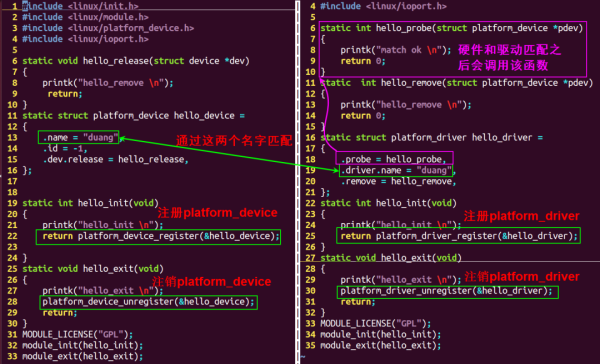
左邊是platform_device結構體注冊的代碼,右邊是platform_driver結構體注冊的代碼。
platform_driver 定義和注冊:
1 #include <linux/init.h> 2 #include <linux/module.h> 3 #include <linux/platform_device.h> 4 #include <linux/ioport.h> 5 6 static int hello_probe(struct platform_device *pdev) 7 { 8 printk("match ok \n"); 9 return 0; 10 } 11 static int hello_remove(struct platform_device *pdev) 12 { 13 printk("hello_remove \n"); 14 return 0; 15 } 16 static struct platform_driver hello_driver = 17 { 18 .probe = hello_probe, 19 .driver.name = "duang", 20 .remove = hello_remove, 21 }; 22 static int hello_init(void) 23 { 24 printk("hello_init \n"); 25 return platform_driver_register(&hello_driver); 26 } 27 static void hello_exit(void) 28 { 29 printk("hello_exit \n"); 30 platform_driver_unregister(&hello_driver); 31 return; 32 } 33 MODULE_LICENSE("GPL"); 34 module_init(hello_init); 35 module_exit(hello_exit);platform_device定義和注冊:
1 #include <linux/init.h> 2 #include <linux/module.h> 3 #include <linux/platform_device.h> 4 #include <linux/ioport.h> 5 6 static void hello_release(struct device *dev) 7 { 8 return; 9 } 10 static struct platform_device hello_device = 11 { 12 .name = "duang", 13 .id = -1, 14 .dev.release = hello_release, 15 }; 16 17 18 static int hello_init(void) 19 { 20 printk("hello_init \n"); 21 return platform_device_register(&hello_device); 22 23 } 24 static void hello_exit(void) 25 { 26 printk("hello_exit \n"); 27 platform_device_unregister(&hello_device); 28 return; 29 } 30 MODULE_LICENSE("GPL"); 31 module_init(hello_init); 32 module_exit(hello_exit);該程序只用于測試platform框架是否可以成功匹配,struct platform_device hello_device 并沒有設置任何硬件信息。
Makfile
1 ifneq ($(KERNELRELEASE),) 2 obj-m:=device.o driver.o 3 else 4 KDIR :=/lib/modules/$(shell uname -r)/build 5 PWD :=$(shell pwd) 6 all: 7 make -C $(KDIR) M=$(PWD) modules 8 clean: 9 rm -f *.ko *.o *.mod.o *.symvers *.cmd *.mod.c *.order 0 endif
該makefile可以同時將兩個C文件編譯成ko文件。
編譯:

編譯
編譯生成的文件:

在這里插入圖片描述
加載模塊
清空log信息 sudo dmesg -c

匹配成功
實例2
給結構體platform_device 增加硬件信息,并在內核中能夠讀取出來。本例向結構體hello_device 增加信息如下:
基址寄存器地址0x139d0000,該地址的空間是0x4
中斷號199 【注意】 實際的內核中會把外設的中斷號根據HW id(通常soc廠商設備soc的時候會給每一個中斷源定義好唯一的ID)計算出一個新的中斷號,該中斷號會被cpu所識別。
device.c
struct resource res[]={ [0] ={ .start = 0x139d0000, .end = 0x139d0000 + 0x3, .flags = IORESOURCE_MEM, }, [1] ={ .start = 199, .end = 199, .flags = IORESOURCE_IRQ, }, }; static struct platform_device hello_device = { .name = "duang", .id = -1, .dev.release = hello_release, .num_resources = ARRAY_SIZE(res), .resource = res, };driver.c
static int hello_probe(struct platform_device *pdev) { printk("match ok \n"); printk("mem = %x \n",pdev->resource[0].start); printk("irq = %d \n",pdev->resource[1].start); //注冊中斷、申請內存 return 0; }重新編譯,卸載第一個例子的模塊,并清除log:
make sudo rmmod device sudo rmmod driver sudo dmesg -c
執行
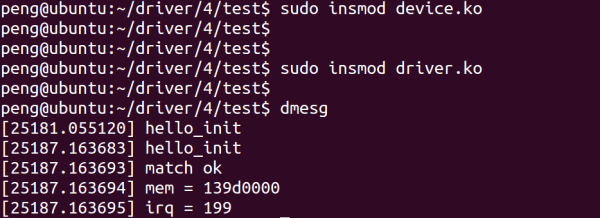
由結果可知,probe函數正確讀取到了硬件信息。
四、platform_device是如何管理的?
1. 沒有設備樹
在沒有設備樹的時候,以三星Cortex-A8 s5pc100為例,硬件信息放在以下位置
arch\arm\mach-s5pc100\Mach-smdkc100.c arch\arm\plat-samsung\
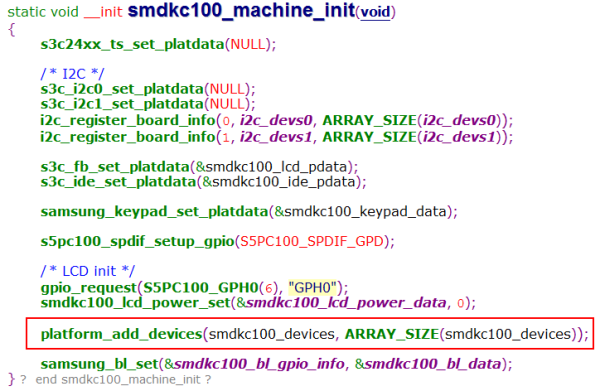
注冊platform_device
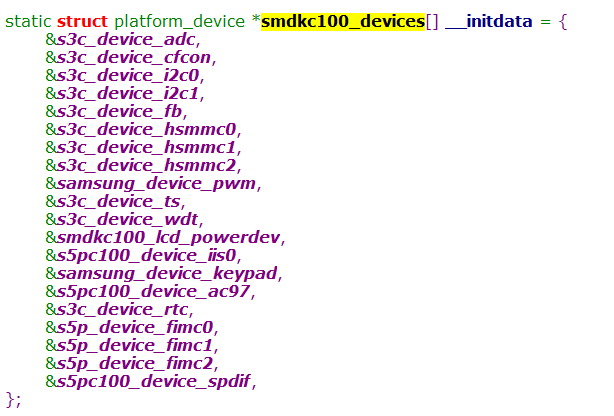
platform_device定義
該數組存放了,內核啟動需要初始化的硬件的信息。
2. 如果有設備樹
內核會有設備初始化的完整代碼,會在內核啟動的時候把設備樹信息解析初始化,把硬件信息初始化到對應的鏈表中。在總線匹配成功后,會把硬件的信息傳遞給probe()函數。
四、總線相關的其他的知識點
1. 內核總線相關結構體變量
內核維護的所有的總線都需要用以下結構體注冊一個變量。
struct bus_type { const char *name; const char *dev_name; struct device *dev_root; struct device_attribute *dev_attrs; /* use dev_groups instead */ const struct attribute_group **bus_groups; const struct attribute_group **dev_groups; const struct attribute_group **drv_groups; int (*match)(struct device *dev, struct device_driver *drv); int (*uevent)(struct device *dev, struct kobj_uevent_env *env); int (*probe)(struct device *dev); int (*remove)(struct device *dev); void (*shutdown)(struct device *dev); int (*online)(struct device *dev); int (*offline)(struct device *dev); int (*suspend)(struct device *dev, pm_message_t state); int (*resume)(struct device *dev); const struct dev_pm_ops *pm; struct iommu_ops *iommu_ops; struct subsys_private *p; struct lock_class_key lock_key; };platform總線變量的定義struct bus_type platform_bus_type定義如下:
struct bus_type platform_bus_type = { .name = "platform", .dev_groups = platform_dev_groups, .match = platform_match, .uevent = platform_uevent, .pm = &platform_dev_pm_ops, };其中最重要的成員是**.match**。
當有設備的硬件信息注冊到platform_bus_type 總線的時候,會遍歷所有platform總線維護的驅動, 通過名字來匹配,如果相同,就說明硬件信息和驅動匹配,就會調用驅動的platform_driver ->probe函數,初始化驅動的所有資源,讓該驅動生效。
當有設備的驅動注冊到platform_bus_type 總線的時候,會遍歷所有platform總線維護的硬件信息, 通過名字來匹配,如果相同,就說明硬件信息和驅動匹配,就會調用驅動的platform_driver ->probe函數,初始化驅動的所有資源,讓該驅動生效。
注冊位置
drivers\base\Platform.c
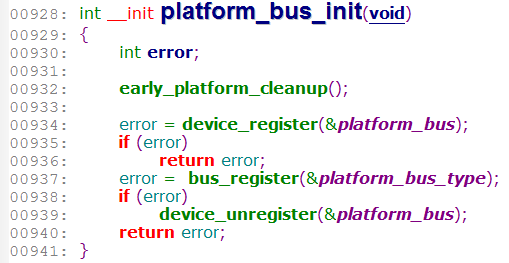
platform_bus_type的注冊
五、注冊代碼流程詳解
捋架構的好處,就是可以幫助我們定位問題
1. match函數何時被調用到?
2. probe函數何時被調用到
以下是上述兩個問題代碼的調用流程:
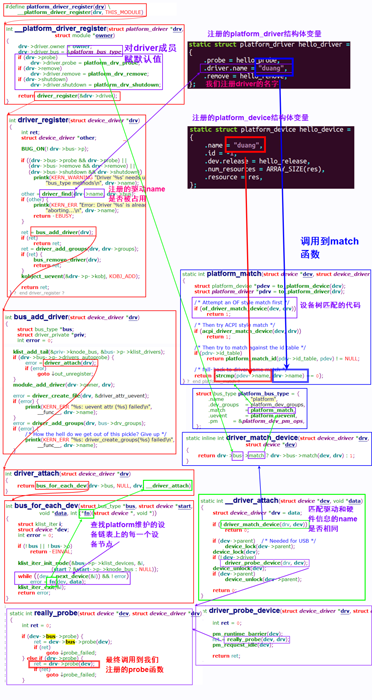
到此,相信大家對“Linux的Platform總線結構體怎么使用”有了更深的了解,不妨來實際操作一番吧!這里是億速云網站,更多相關內容可以進入相關頻道進行查詢,關注我們,繼續學習!
免責聲明:本站發布的內容(圖片、視頻和文字)以原創、轉載和分享為主,文章觀點不代表本網站立場,如果涉及侵權請聯系站長郵箱:is@yisu.com進行舉報,并提供相關證據,一經查實,將立刻刪除涉嫌侵權內容。